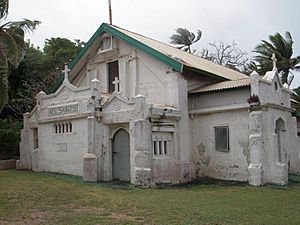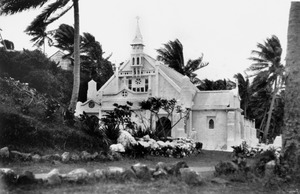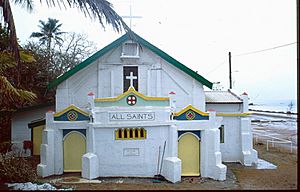All Saints Anglican Church, Darnley Island facts for kids
Quick facts for kids All Saints Anglican Church, Darnley Island |
|
|---|---|

All Saints Anglican Church, 2011
|
|
| Location | Darnley Island, Torres Strait Island Region, Queensland, Australia |
| Design period | 1870s–1890s (late 19th century) |
| Built | 1919–1938 |
| Architectural style(s) | Romanesque |
| Official name: All Saints Anglican Church | |
| Type | state heritage (built, landscape) |
| Designated | 21 October 1992 |
| Reference no. | 600873 |
| Significant period | 1870s–1920s (historical) 1910s–1940s (fabric) |
| Significant components | apse, views to, trees/plantings, wall/s – sea, church |
| Lua error in Module:Location_map at line 420: attempt to index field 'wikibase' (a nil value). | |
All Saints Anglican Church is a special old church located on Darnley Island in the Torres Strait Island Region of Queensland, Australia. It was built between 1919 and 1938. This church is so important that it was added to the Queensland Heritage Register on October 21, 1992, meaning it's protected for its historical value.
Contents
The Story of Christianity in the Torres Strait
How the Light Came to the Islands
The story of Christianity arriving in the Torres Strait Islands is known as the "Coming of the Light." It's a very important event for the people there.
The first Christian missionary arrived in Queensland in 1867. However, the mission closed soon after.
Then, in 1871, missionaries from the London Missionary Society (LMS) sailed to the Torres Strait on a ship called the Surprise. They were two Englishmen and eight evangelists from Lifu (an island in the Pacific).
They reached Erub, also known as Darnley Island, on July 1, 1871. This day is now celebrated every year. Dabad, an elder from the island, met them at Kemus Beach. He became friends with the missionaries and helped them meet other islanders. Dabad's role is remembered with a monument on the island.
On July 5, two Lifu evangelists, Mataika and Guchong, stayed on Erub to teach about Christianity. The Surprise then sailed to other islands, leaving more evangelists to share their message.
Spreading the Christian Message
The London Missionary Society set up a base in Somerset, Queensland, to help spread Christianity to other Torres Strait Islands and New Guinea. Many Pacific Islander teachers helped with this work between 1871 and 1878.
By 1872, the missionaries reported that they were holding weekly services on Erub. The services were in a mix of the local language, Kalaw Lagaw Ya, which eventually led to a new language developing in the Torres Strait.
The Queensland Government took control of the Torres Strait Islands in 1872 and 1879. This was partly to control important shipping routes and the valuable pearl and beche-de-mer (sea cucumber) industries.
The London Missionary Society also opened a school on Mer Island to train Torres Strait Islanders to become priests. This school helped local priests learn both missionary teachings and Islander customs.
The Anglican Church Takes Over
By 1890, the London Missionary Society started to reduce its work in the Torres Strait. They felt their mission was successful there and wanted to focus on New Guinea.
In 1914, the Anglican Church took over the missionary work in the Torres Strait. They continued the important work started by the London Missionary Society.
Soon after, the Anglican Church began the annual "Coming of the Light" celebrations. This event honors the arrival of the missionaries and is still celebrated by Torres Strait Islanders today. Kemus Beach on Erub is a very important place for these celebrations. There's a large white cross there, shaped like a ship, to remember the Surprise and the "Coming of the Light."
Building All Saints Church
In 1919, the All Saints Church was built on the same spot where the first London Missionary Society mission house and school once stood. Local people made the building materials, using lime from burnt coral and basalt rock. Manai, an Erub Islander, and Ware, a South Sea Islander, led the construction work. The church was first called the Ziona church.
In 1963, the Anglican Church updated the building. They used limestone from nearby coral reefs. The roof was made taller, and the inside walls were extended.
Over time, the beach near the church started to erode. To protect the church from strong tides, a stone sea wall was built in 1976, about 15 meters away from the building.
What the Church Looks Like
All Saints Church is a strong concrete building with a red roof made of corrugated asbestos cement and galvanized steel. It stands very close to Badog Beach on the southwest side of Erub (Darnley) Island.
The church covers an area of about 250 square meters. It has a main central area called a nave with side sections. The concrete walls are thick, about 300 to 450 millimeters, and are smooth inside and out. The inside walls between the main area and the side sections are white and have arched columns. The floor is also concrete.
The front of the church, facing east, has decorations like a niche (a small alcove), columns, beams, and other architectural details. The main door is on the southern side, through one of the side sections. The outside walls of the side sections have strong supports called buttresses at the corners and in between. The sanctuary, which is the holy part of the church, is at the western end, with a small room called a vestry extending to its southern side.
The church is located on a flat area between the beach and a small headland. The area around it has tall coconut palms and natural forest.
Why All Saints Church is Important
All Saints Anglican Church is listed on the Queensland Heritage Register because it is very important for several reasons:
- It shows how history unfolded: The church is a key reminder of how Christian missionary work developed in the Torres Strait. It's also the main place for the annual "Coming of the Light" festival, which celebrates the arrival of the London Missionary Society in 1871.
- It has beautiful design: This large building, made in 1919 from local materials like burnt coral and basalt, is a striking landmark on Erub (Darnley) Island. Its location on Badog Beach and its unique style, with projecting corners and strong cement construction, make it very special to look at.
- It has strong community ties: Erub (Darnley Island) is deeply important to Torres Strait Islander Christians. It was the very first place where Torres Strait Islanders met the London Missionary Society missionaries, making it a sacred site for their faith and culture.




